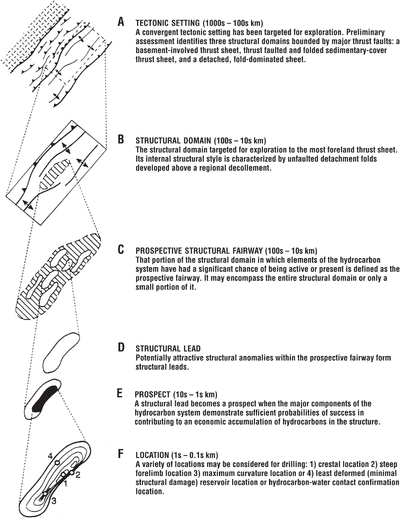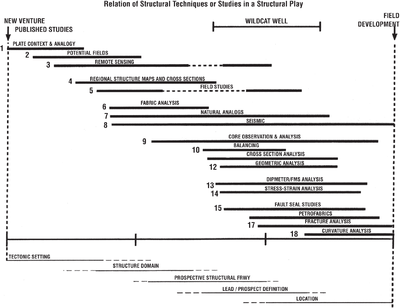Difference between revisions of "Structural exploration workflow"
Cwhitehurst (talk | contribs) |
Cwhitehurst (talk | contribs) m (added Category:Treatise Handbook 3 using HotCat) |
||
| (23 intermediate revisions by 2 users not shown) | |||
| Line 6: | Line 6: | ||
| part = Predicting the occurrence of oil and gas traps | | part = Predicting the occurrence of oil and gas traps | ||
| chapter = Exploring for structural traps | | chapter = Exploring for structural traps | ||
| − | | frompg = 20- | + | | frompg = 20-40 |
| − | | topg = 20- | + | | topg = 20-42 |
| author = R.A. Nelson, T.L. Patton, S. Serra | | author = R.A. Nelson, T.L. Patton, S. Serra | ||
| link = http://archives.datapages.com/data/specpubs/beaumont/ch20/ch20.htm | | link = http://archives.datapages.com/data/specpubs/beaumont/ch20/ch20.htm | ||
| Line 17: | Line 17: | ||
==The workflow== | ==The workflow== | ||
| − | + | ||
| − | We begin by envisioning a structural play concept based on the thrust belt play of the U.S. Rocky | + | We begin by envisioning a [[Structural trap system|structural play]] concept based on the [[thrust belt]] play of the U.S. [[Rocky Mountains]] area. The following workflow discussion tracks this play concept from inception to drill location through a “normal” structural exploration process, as shown in [[:file:exploring-for-structural-traps_fig20-3.png|Figure 1]]. |
| + | |||
| + | [[file:exploring-for-structural-traps_fig20-3.png|thumb|left|400px|{{figure number|1}}Play concept from inception to drill location through a “normal” structural exploration process.]] | ||
| + | {{clear}} | ||
==Effects of scale== | ==Effects of scale== | ||
| − | [[file:exploring-for-structural-traps_fig20-4.png|thumb|{{figure number|2}}Different techniques and tools | + | [[file:exploring-for-structural-traps_fig20-4.png|400px|thumb|{{figure number|2}}Different techniques and tools used for structural interpretation.]] |
| − | The technical tasks we identify are often related to the scale of our observation, from regional to microscopic. [[:file:exploring-for-structural-traps_fig20-4.png|Figure 2]] summarizes where the different techniques and tools described in | + | |
| + | The technical tasks we identify are often related to the scale of our observation, from regional to microscopic. [[:file:exploring-for-structural-traps_fig20-4.png|Figure 2]] summarizes where the different techniques and tools described in [[structural interpretation techniques and tools]] can be applied. This sequence of tasks, in varying degrees, applies to any structural play. | ||
| + | |||
| + | We limit or reduce the number of structural techniques applied by the inherent maturity of the basin or play. In general, those techniques involving data and data generation on a large or reconnaissance scale (left half, [[:file:Exploring-for-structural-traps fig20-4.png|Figure 2]]) are most important to perform early in a frontier basin or play. More detailed analyses requiring more detailed data (right half, [[:file:Exploring-for-structural-traps fig20-4.png|Figure 2]]) are appropriate only to more mature basins and development studies/plays. | ||
| + | |||
| + | These are depicted in the table below by a common basin/play maturity classification. | ||
| + | |||
| + | {| class = "wikitable" | ||
| + | |- | ||
| + | ! Maturity Level || Very Important* | ||
| + | |- | ||
| + | | Frontier || 1, 2, 3, 7, reconnaisance 5 | ||
| + | |- | ||
| + | | Emergent || 4, 5, 7, 8 stratigraphic, 10 | ||
| + | |- | ||
| + | | Established || 6, 9, 11, 13, 14 | ||
| + | |- | ||
| + | | Mature || 6, 8 (rock properties), 9, 13, 15 | ||
| + | |} | ||
| + | <sup>* For number reference, see [[:file:Exploring-for-structural-traps fig20-4.png|Figure 2]]</sup> | ||
==See also== | ==See also== | ||
* [[Tectonic setting]] | * [[Tectonic setting]] | ||
* [[Structural domains]] | * [[Structural domains]] | ||
| − | * [[ | + | * [[Structural fairway prospectivity]] |
| − | * [[ | + | * [[Structural lead and prospect delineation]] |
| − | * [[ | + | * [[Structural exploration:location selection]] |
| − | * [[ | + | * [[Structural exploration: thrust belt example]] |
| + | * [[Data and techniques that delineate structural styles]] | ||
| + | * [[How different structural philosophies govern techniques]] | ||
{{clear}} | {{clear}} | ||
| + | |||
==External links== | ==External links== | ||
{{search}} | {{search}} | ||
| Line 39: | Line 64: | ||
[[Category:Predicting the occurrence of oil and gas traps]] | [[Category:Predicting the occurrence of oil and gas traps]] | ||
[[Category:Exploring for structural traps]] | [[Category:Exploring for structural traps]] | ||
| + | [[Category:Treatise Handbook 3]] | ||
Latest revision as of 16:22, 3 February 2022
| Exploring for Oil and Gas Traps | |

| |
| Series | Treatise in Petroleum Geology |
|---|---|
| Part | Predicting the occurrence of oil and gas traps |
| Chapter | Exploring for structural traps |
| Author | R.A. Nelson, T.L. Patton, S. Serra |
| Link | Web page |
| Store | AAPG Store |
This section suggests a flow of tasks to help explorationists define a drill location, moving from the regional scale to the drill site. The discussion is from the perspective of a full-cycle exploration play, where we have a play concept and are looking for a drill location to test it.
The workflow
We begin by envisioning a structural play concept based on the thrust belt play of the U.S. Rocky Mountains area. The following workflow discussion tracks this play concept from inception to drill location through a “normal” structural exploration process, as shown in Figure 1.
Effects of scale
The technical tasks we identify are often related to the scale of our observation, from regional to microscopic. Figure 2 summarizes where the different techniques and tools described in structural interpretation techniques and tools can be applied. This sequence of tasks, in varying degrees, applies to any structural play.
We limit or reduce the number of structural techniques applied by the inherent maturity of the basin or play. In general, those techniques involving data and data generation on a large or reconnaissance scale (left half, Figure 2) are most important to perform early in a frontier basin or play. More detailed analyses requiring more detailed data (right half, Figure 2) are appropriate only to more mature basins and development studies/plays.
These are depicted in the table below by a common basin/play maturity classification.
| Maturity Level | Very Important* |
|---|---|
| Frontier | 1, 2, 3, 7, reconnaisance 5 |
| Emergent | 4, 5, 7, 8 stratigraphic, 10 |
| Established | 6, 9, 11, 13, 14 |
| Mature | 6, 8 (rock properties), 9, 13, 15 |
* For number reference, see Figure 2
See also
- Tectonic setting
- Structural domains
- Structural fairway prospectivity
- Structural lead and prospect delineation
- Structural exploration:location selection
- Structural exploration: thrust belt example
- Data and techniques that delineate structural styles
- How different structural philosophies govern techniques

